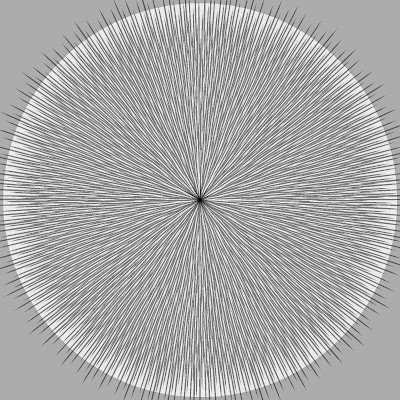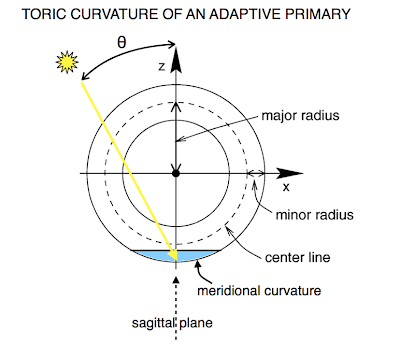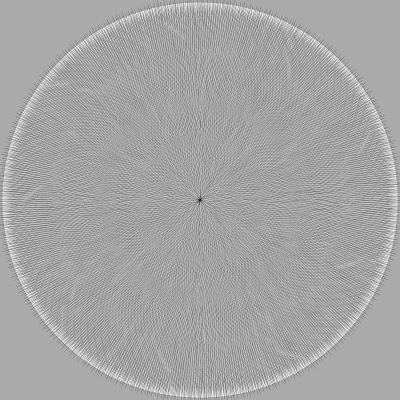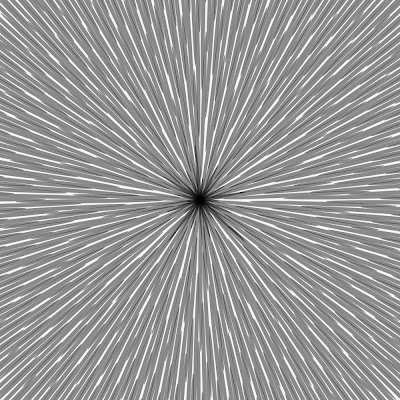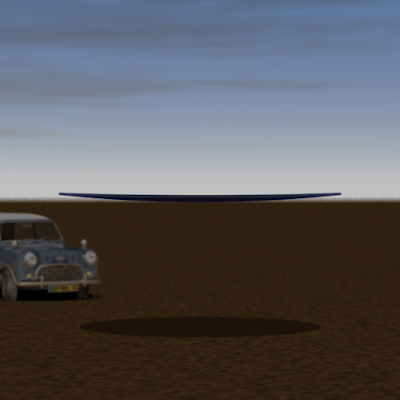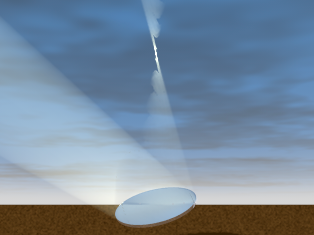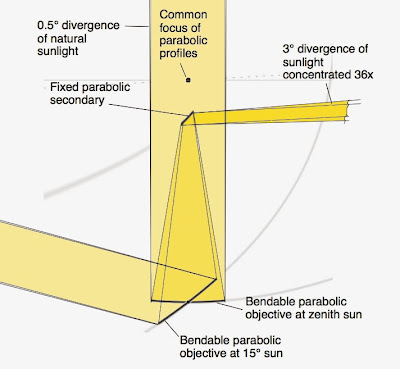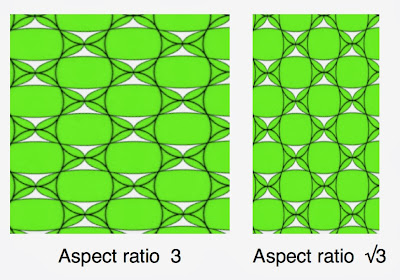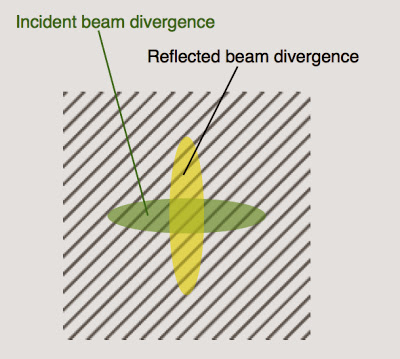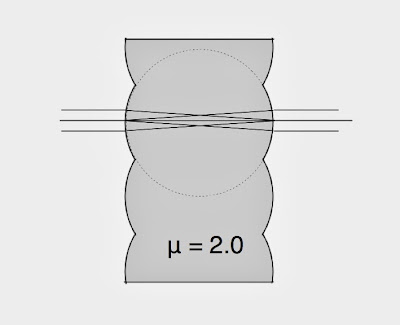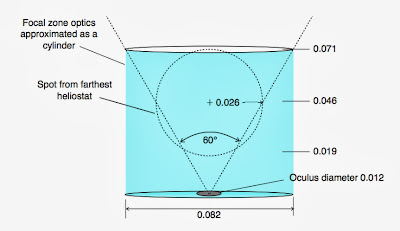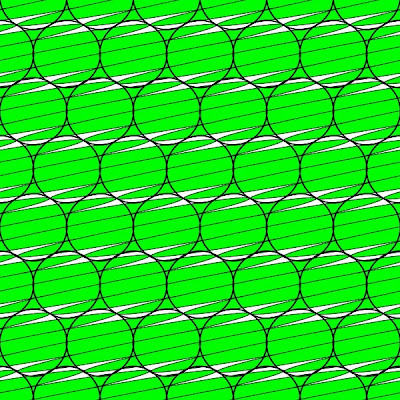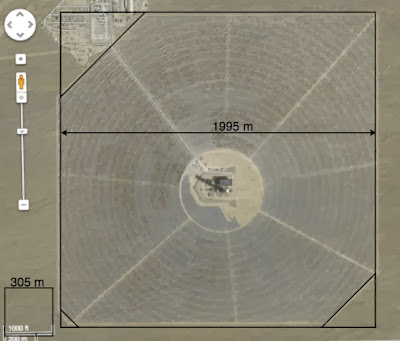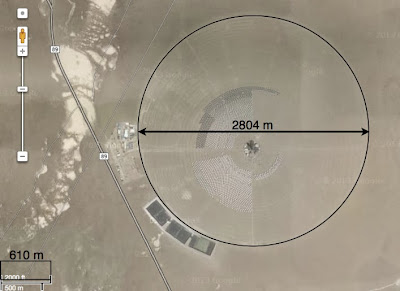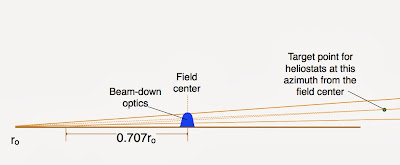 |
| Cross-section of an array of telescopic heliostats showing the target point for all heliostats lying at the same azimuth to the field center. The field radius is 14 times the height of the beam-down optics—about twice the comparable ratio for conventional heliostats. |
Aiming slightly low in the outer portion of the heliostat field, and slightly high in the inner portion of the field, offers the advantage of making the focal zone more compact. This variable aiming can be idealized as aiming all the heliostats that lie on the same azimuth from the origin toward a single target point behind the focal zone. When heliostats are targeted in this way, the locus of the geometric constraint—the ideal shape of the beam-down optics—is no longer a family of confocal parabolas, instead it is a family of ellipses having as their foci the target point and the oculus center.
Whatever happens near the inner radius of the field is of minor importance due to the relatively small number of heliostats involved. On the other hand, what happens with heliostats near the outer radius of the field is important because there are the most numerous rows of heliostats.
Low-aiming of heliostats at the periphery can be carried too far. With constant aiming, the lowest ray in the beam from a secondary rises at only beta/2 (1:36 with 6x telescopic heliostats.) Lowering aim by a mere beta/2 would send the lowest rays traveling horizontally—guaranteeing that they would hit the back of another secondary. In fact, any lowering of the aiming angle will entail either some blocking by other secondaries (should we keep the primaries close-packed) or a decrease in land utilization (if we space the primaries out.) An optimized system will always have a bit of every possible kind of loss: all the possible losses come out to play in the big trade-off game. For the purpose of a simple baseline design we can be arbitrary: we will insist on zero blocking loss, but we will permit the land utilization in the outermost row to fall to 2/3.
 |
| The circles are the primary mirrors viewed from above; the ellipses are the shadows cast on a horizontal plane by the secondaries when illuminated from the direction of the lowest ray in there beam. |
In a system with 6x telescopic heliostats, the beam spread is 3°, and the nominal beaming angle is 3.1°. That leaves the lowest rays in the beam directed 1.6° above horizontal, or a run-over-rise of 36:1. The ellipses in the figure above are 9:1, they would need to be elongated to 36:1, but still with the same surface area, to represent the design condition. Aiming lower while keeping blocking at zero means that the ellipses must be further elongated, but this time the dimension of the minor axis is kept constant and the surface area is allowed to increase. The surface area of the circles (which represent the primary mirrors) are not allowed to change when we aim lower because we are using the same design of heliostats over the whole field. Therefore, the area increase of the ellipses associated with low-aiming is balanced by extra empty space between primaries.
At the last row we allow 2/3 land utilization, meaning that low-aiming is permitted to increase the surface area of the ellipses by 50%: their aspect ratio can increase from 36:1 to 54:1. So, at the last row, the lowest ray can have a run-over-rise of 54:1, which is an elevation angle of 1.1°. Recalling that the beam spread is 3°, the middle ray will have an elevation angle of 2.6°, or a run-over-rise of 22:1; the top ray will have an elevation angle of 4.1°, or a run-over-rise of 14 (putting that in a short hand, the outer heliostat operates at: 14-22-54, in run-over-rise numbers, which are also the reciprocals of the elevation angles measured in radians.) By comparison, a heliostat at its design condition operates at 12.4-18.5-36.
The unique row of heliostats that operates with both design condition aiming and chock-a-block packing should be located somewhere near the median radius of the field (outer radius / sqrt 2.) The top image diagrams such a system. The target point turns out to be little bit higher than the beam-down optics, and about one field radius behind the center of the field.
 |
| Calculation of target position, where γ is the ratio of design beaming angle, β, to the beaming angle, βe at the outer radius, ro; and r is the target point's radial distance from the center of the field. Heliostats operating at the design condition are assumed to lie at the median radius (0.707 * ro) from the center of the field. In this example γ = 22/18.5 = 1.19, so r/ro = 0.84. The height of the target point is then ro * (1 + 0.84) / 22 = .084 ro . |
The run-over-rise number for the top ray of the outermost heliostats—in this example, 14—is also the ratio of the field radius to the tower height (or height at the top of the beam-down optics.) Telescopic heliostats give twice the value for conventional heliostat fields, but with much better land utilization.




